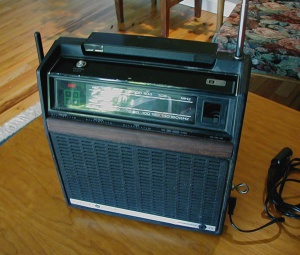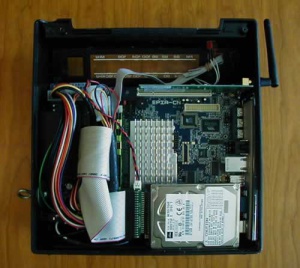8track
My quest for low power systems began in my Carbon diet page and now it continues with this system. It is smaller, faster, and uses less energy than the earlier Via EPIA 800 system. I migrated from the C3 to the C7 system.
Origin of the name 8track. When I was riding around Corvallis one day, I saw a pile of free stuff in front of someone's house. Right on top was a GE portable AM/FM 8 track player. I could not pass it up. I immediately envisioned putting a computer in the case and that is exactly what happened.
I realize now that I could probably have sold it for $10 on Ebay! Well, I have gotten more than $10 worth of entertainment out of it so far.
I used 8track as the unofficial [Solar CREEK kiosk] at DaVinci Days 2006. It ran off solar power all day playing a video and allowing access to the Solar CREEK Web site.
Alas it is no longer in the 8 Track player but I stuck with the name.
Hardware specs
"8track" was originally a complete computer system based on a Via CN10000 Mini-ITX board built inside the 8 track player case. The overpriced Morex automotive power supply died when it was less than a year old. Rather than throw more money at Morex, I replaced the case with a commercially built slim case.
8track currently has
- Via CN10000 C7 mainboard
- 1GB RAM
- 80 GB 7200 rpm Seagate SATA drive
- Casetronic case
With the Morex automotive power supply the power options included using either an old HP Omnibook 800 laptop power supply or a 12 volt gel cell. At the Solar CREEK booth at DaVinci Days, I ran it on a solar panel and a 120 vac inverter.
Originally I used the 2.5" drive because the Morex did not support the power requirements of a 3.5" drive on its 12V output. A Toshiba 4200 rpm 30 GB drive was IDE (PATA) and plugged into a 44-40 pin adapter. The Seagate SATA drive is a huge improvement, it's much faster.
At DaVinci days, I used an Acer 15" display and a PS/2 keyboard and mouse. The monitor ran off the inverter, too. I plugged in stereo speakers and connected to the Solar CREEK web site via a wireless link.
The HP power supply puts out about 35 watts and it had no trouble running this machine in the above configuration. I measured output of the supply and found it took about 10 watts to run.
I need to take measurements on the new configuration.
Main board
I bought the CN10000EG fanless C7 board from Logic Supply.
Mini-review: The CN10000 board works quite well as a server, but it does not have enough juice to run the Java Netbeans IDE and the video drivers are not up to snuff for Ubuntu Hardy Heron.
Maybe the video chip itself WOULD work but the drivers don't support the high end Gnome features. I am not sure. I wish that Via did more work to support their products or at least open them up. They dandy hardware like graphics and media decoder and encryption chips on the board then do not provide up-to-date Linux drivers for them.
I got my EPIA C3 800 Mhz mainboard from Logic Supply, too. It has since died. I abused it, static probably got it.
Some specs:
VIA CN700 north bridge VIA VT8237R south bridge LAN: VIA VT6103 10/100 AUDIO: VIA VT1618 8 channel AC'97 codec
File:CN10000.pdf PDF manual
C7 kernels
When I first got the C7 board I had to build a custom kernel because it was not supported by default on Ubuntu. Currently I use the standard Ubuntu kernels but here are my old notes on kernel building for the C7.
http://www.howtoforge.com/kernel_compilation_ubuntu_p2?s=2e4e7db1d3b0009a48132ba132e72f9e&
make-kpkg clean fakeroot make-kpkg --initrd build kernel_image kernel_headers modules
This builds the packages up one layer, you have to go there and install them.
cd .. sudo dpkg -i packagename ..and so on
Software
2010-Jan-02
This machine is currently being used to test FreeSwitch so I have Debian 5 installed on it.
Freeswitch
Official Getting Started Guide
1. Edit /opt/freeswitch/conf/var.xml
- Change SIP service provider
- Change password
- Change area code
- Change outbound caller name and caller id.
2. Edit /opt/freeswitch/conf/autoload_configs/modules.conf.xml
What is XMPP?
Old Pictures

A wood strip is fitted to cover over empty slots left when I removed the various controls (volume, tone and so on.) It fits the style of cases of this vintage though it's real hardwood not contact paper!

Here you can see the interior layout.
There is enough room at the top of the case to accomodate an LCD display. The Trendnet Wifi card fit in easily once I removed its card slot adapter.
I used a router* to enlarge the 8-track slot to fit the mainboard back panel. The styrene plastic is very easy and clean to work with a carbide bit. I probably won't get cancer for many more years.
The large metal ring on the left is an eye bolt to allow me to lock down the case when I leave it unattended in public places.
- Def router: a motor with a spinning cutter attached, not a network device.